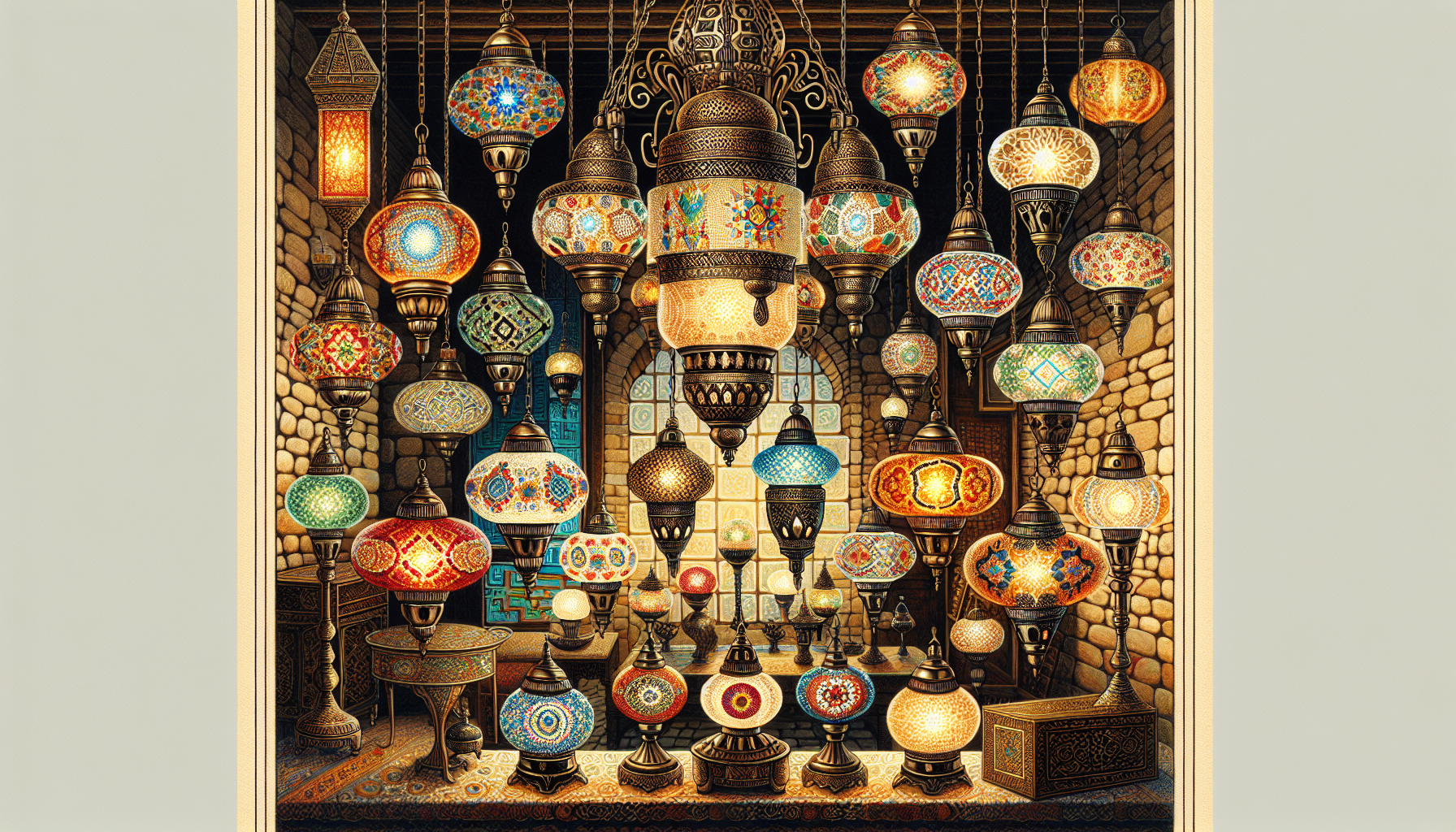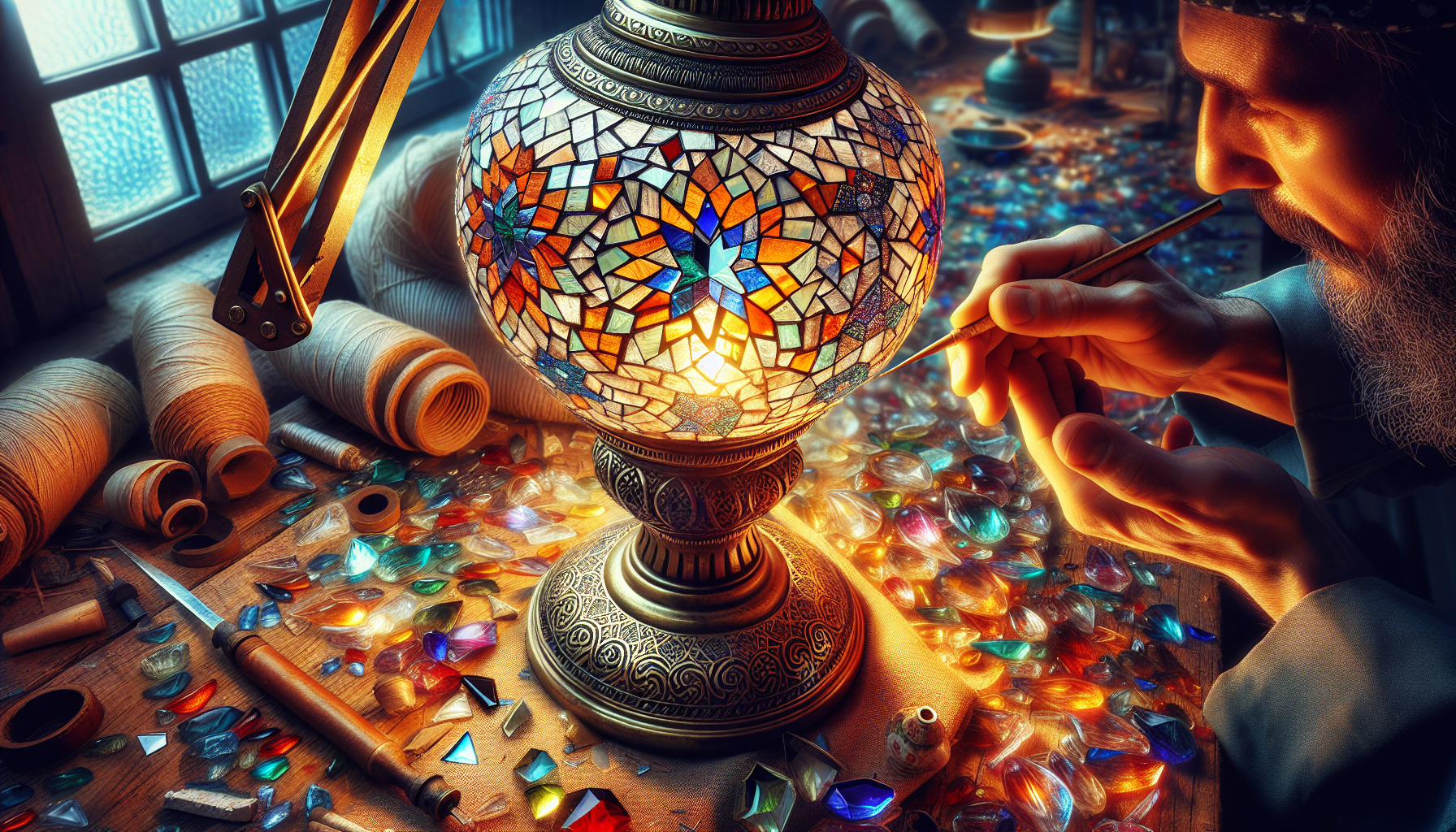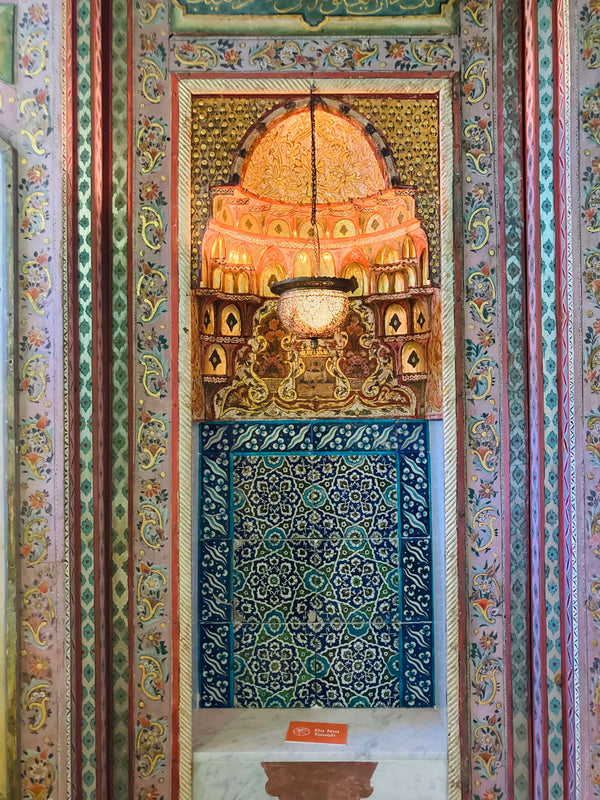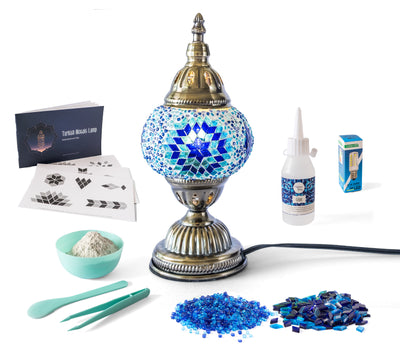This article explores the origins, development, and cultural importance of Turkish lamps. The technique of making these lamps was born 5,000 years ago in ancient empires where advanced methods were developed and perfected. This is the base of the intricate workmanship of these lamps today. Also how these beautiful lamps evolved over time and became a symbol of art and cultural heritage.

Key Takeaways
-
Turkish mosaic lamps have evolved from Byzantine and Persian influences, combining diverse artistic elements and techniques over centuries, especially during the Ottoman Empire where they symbolized artistic sophistication and grandeur.
-
The traditional production process of Turkish mosaic lamps is meticulous and labor-intensive, involving hand-cutting glass, arranging it on a hand-blown glass base, and using high-quality materials like brass or bronze, ensuring each lamp is a unique piece of art.
-
Turkish mosaic lamps hold significant cultural symbolism, often believed to ward off bad luck and negative energy, and feature intricate non-figurative designs influenced by aniconism in Islam, making them appreciated globally for their artistic beauty and historical heritage.
Origins of Turkish Mosaic Lamps

The origins of Turkish mosaic lamps are steeped in history, tracing back to the magnificent Byzantine and Persian empires. These early civilizations, renowned for their elaborate mosaics, laid the foundation for what would evolve into the stunning Turkish mosaic lamps we cherish today. The art of mosaic itself dates back to around the 4th millennium BC, where it adorned the homes of the wealthy, symbolizing eternity and opulence.
As centuries passed, Turkish mosaic lamps evolved, embodying a blend of diverse artistic elements and techniques from various cultures. Their journey is marked by a seamless integration of Byzantine and Persian art, culminating in vibrant and intricate designs that became synonymous with the Ottoman Empire. Here, these lamps were not just sources of light but symbols of artistic sophistication and grandeur, illuminating the grand palaces and religious sites of the era.
Early Influences

The design and construction technique of Turkish mosaic lamps were significantly shaped by the artistic heritage of the Byzantine and Persian empires. The elaborate mosaics that adorned Byzantine churches and palaces played a crucial role in shaping the aesthetics of these lamps. Persian art’s intricate geometric patterns and vibrant colors served as inspiration for their detailed designs.
Master artisans adapted the glass and ceramic work found in Persian and Byzantine mosaics to create what we now recognize as Turkish mosaic lamps, honing an already exquisite form of art into something uniquely beautiful.
Evolution Through Centuries

For generations, the art of making Turkish mosaic lamps has been refined and transformed, drawing upon a diverse blend of inspirations and techniques. These lamps have their roots in the Byzantine mosaics witnessed within the Hagia Sophia, but over time they absorbed elements from Czech Bohemian glass artisans and Venetian ‘glass ice’ methods. This cross-cultural fusion enhanced their visual charm by integrating various materials such as beads, plaster, and glass into their design.
With each passing epoch came an added dimension of intricacy to these mosaic lamps—solidifying them not only as utilitarian objects but also as enduring works of beauty that mesmerize onlookers even today.
Role in Ottoman Empire

During the Ottoman Empire, Turkish mosaic lamps were pivotal in both cultural and religious environments. These intricately designed lamps adorned palaces, embodying the luxury and aesthetic discernment of the ruling class. They served to light up mosques and other spiritual venues, highlighting their significance within the sociocultural and faith-based aspects of that era.
The complex patterns and lively hues associated with these mosaic lamps became emblematic of Ottoman artistic refinement. This heritage endures to this day, as the Turkish mosaic continues to cast its luminous legacy across generations.
Turkish Mosaic Lamps in Modern Day Turkey

Do you think every Turkish home has a Turkish mosaic lamp? Growing up in Istanbul, I, as a native Turk, didn't see my first mosaic lamp until I was 17. They weren't a common part of our daily lives. Over time, our culture has evolved, and mosaic lamps have become more popular as tourist souvenirs and authentic restaurant decorations rather than everyday household items. However, most Turkish homes still have an evil eye, which we hang on walls or place in cars, believing it protects us from people with evil intentions or envy.
Traditional Production Process

Reflecting the dedication and craftsmanship of skilled artisans, the traditional production process of Turkish mosaic lamps is meticulous and labor-intensive. Each lamp is a unique piece of art, crafted entirely by hand in Turkey without the use of mechanization. This process begins with hand-cutting sections from larger sheets of handmade glass, which are then arranged on a clear, hand-blown glass base using a slow-drying adhesive.
Once the individual glass pieces are in place, a special paste is applied to fill the gaps, ensuring durability and visual appeal. The final stages involve fitting the mosaic-covered globe into a metal framework, often made of brass, and meticulously cleaning off any excess paste. This hands-on approach ensures that each Turkish mosaic lamp is not only a functional lighting fixture but also a testament to the artisan’s skill and creativity.
Materials Used

Crafted from an elegant assortment of materials, Turkish mosaic lamps have undergone a remarkable evolution. From their early days featuring ceramics and metals to the contemporary incorporation of plaster and glass. These intricate lamps are now fashioned with handcrafted, colored glass pieces varying in color and thickness, laid on clear blown-glass bases, coupled with components made from premium brass or bronze.
These durable Turkish mosaic pieces showcase meticulous metal craftsmanship alongside dazzling colors brought to life by tiny crystals—ensuring that each lamp is not only heat-resistant but also aesthetically captivating.
Craftsmanship Techniques
The process of making Turkish mosaic lamps is an intricate one that fuses time-honored craftsmanship skills. Craftsmen painstakingly hand-cut pieces of glass into particular sizes and shapes, then methodically arrange them onto a clear glass base using a slow-setting glue for meticulous assembly. This delicate procedure allows each shard to be deliberately placed by hand, demanding substantial patience and exactitude to accomplish the complex designs intrinsic to these lamps.
Consequently, every mosaic lamp emerges as an exclusive piece of art, emblematic of the artisan’s commitment and skillful execution in their craft. Each Turkish mosaic creation becomes not just a source of light, but also reflects the profound artisanship invested in its conception.
Assembly and Final Touches
Crafting Turkish mosaic lamps involves a meticulous process that blends precision with artistic skill. The key stages in this process are as follows:
-
Carefully placing the pieces of glass
-
Bridging the interspaces with specialized adhesive paste
-
Employing unique cleaning agents to eliminate any surplus adhesive
-
Refining any rough edges using a wire wheel attached to an automated lathe
Such diligent attention guarantees that each piece emerges not just as a functional lamp but also as an exquisite work of art.
Upon assembly, the intricate mosaic shade is mounted into either brass or bronze framework, thus transforming it into an elegant mosaic table lamp ready to enhance the ambiance of its intended space.
Cultural Significance and Symbolism
More than just beautiful objects, Turkish mosaic lamps are imbued with rich cultural significance and symbolism. Often known as ‘evil eye’ lamps, they are believed to ward off bad luck and negative energy, reflecting deep-rooted cultural beliefs. These lamps symbolize Turkey’s rich cultural heritage, embodying centuries of artistic traditions and history.
Their intricate designs and vibrant colors are a testament to the skilled craftsmanship and artistic sophistication that have been passed down through generations, giving each piece its unique shape.
Aniconism in Islam

The practice of aniconism within Islam, which discourages the depiction of sentient beings, has considerably impacted Turkish mosaic lamp design. This stems from a prohibition on idol worship and the notion that only God should create life forms. Consequently, Islamic art usually showcases patterns that are calligraphic, geometric, or abstract floral rather than figurative.
This impact is clearly reflected in the complex and non-representational designs typical to Turkish mosaic lamps. These lamps utilize arabesque motifs and geometric configurations extensively to produce their impressive visual allure.
Symbolic Patterns

The intricate patterns found on Turkish mosaic lamps are not merely decorative, but also imbued with profound cultural meanings. The central blue cyan star pattern seen in numerous lamps is emblematic of safeguarding against misfortune or harmful energies. Meanwhile, the undulating designs signify life’s perpetual motion and the steady movement of water. These motifs do more than just beautify the lamps. They reflect significant cultural principles and convictions deeply rooted within the tradition of Turkish mosaic craftsmanship.
Influence on Modern Decor

Turkish mosaic lamps have carved a distinctive niche in modern interior decoration, renowned for their eclectic and vivid patterns. These luminaries infuse an air of sophisticated charm into modern settings, establishing themselves as central features while introducing dynamic hues.
In the realm of ambient decor, every lamp is distinguished by its singular mosaic craftsmanship that can metamorphose any room into a cozy sanctuary. Beyond mere lighting solutions, these artifacts represent historical treasures and artistic splendor capable of enhancing the visual appeal of contemporary living spaces.
Global Appeal
Turkish mosaic lamps, with their elaborate patterns and enduring motifs, have been casting a warm glow across spaces in Turkey, the Middle East, and Europe for numerous generations. This art form has mesmerized admirers worldwide thanks to its stunning beauty and exquisite craftsmanship. As coveted collectibles, these mosaic lamps are renowned for their distinctive designs that reflect cultural traditions—making them cherished acquisitions capable of infusing any space with the allure and historical depth of Turkish charm.
Different Styles of Turkish Lamps

In a multitude of styles, the Turkish mosaic lamp is a testament to time-honored craftsmanship and boasts vivid patterns. The assortment encompasses several popular designs.
-
Table lamps
-
Hanging lamps
-
Chandeliers
-
Floor lamps
These adaptable lighting pieces are capable of elevating the mood in any space.
Every style emphasizes elaborate glasswork and an array of rich hues, rendering these lamps appropriate for diverse environments whether it be intimate sleeping quarters or expansive social spaces.
Table Lamps
Table lamps crafted in the Turkish mosaic style are renowned for their:
-
Space-efficient and adaptable forms
-
Elaborate designs featuring geometric shapes and floral elements
-
Blend of colorful glass fragments and beads that create detailed patterns
-
Captivating, ornate aesthetics
-
Classic motifs inspired by Ottoman heritage
Due to their diminutive stature, these lamps play an integral role in bringing a sophisticated flair to any home space, be it a cozy nook or atop furniture surfaces.
Hanging Lamps and Chandeliers

Turkish mosaic lamps, with their vibrant hues and intricate patterns, can completely transform the vibe of any space when suspended as lamps or chandeliers. They serve as striking features within a room’s decor.
Featuring a collection of hanging lanterns adorned in distinctive floral or geometric motifs, Turkish mosaic chandeliers exude a cozy and welcoming ambiance. These lighting fixtures are perfect for establishing an engaging centerpiece in any environment they’re placed into.
Other Types
Floor lamps, among other varieties of Turkish lighting, provide flexible options for both interior and exterior spaces. Serving as focal points in decor due to their substantial size and elaborate patterns, these more considerable lamps infuse any area with a sense of heritage and authenticity. They are ideal for making a bold decorative statement within a room while elevating its aesthetic appeal through their enduring elegance.
Quality and Authenticity

Recognizing the authenticity and quality of Turkish mosaic lamps is essential when you’re seeking to acquire a legitimate work of art. These genuine pieces are meticulously handcrafted by master craftsmen who employ time-honored methods that have been inherited through multiple generations. True Turkish mosaic craftsmanship is marked by its detailed glasswork and precise construction, something not found in mass-produced replicas.
The materials used in superior-quality Turkish mosaic lamps, including glass and brass along with other metals, guarantee both resilience and visual attractiveness over an extended period.
Recognizing Genuine Craftsmanship
Recognizing authentic craftsmanship is crucial in distinguishing genuine Turkish mosaic lamps from their mass-produced counterparts. True handcrafted lamps exhibit subtle variations, a hallmark of the individual artistry employed by artisans. The glass used in these authentic mosaic lamps retains its vibrant, deep color even when illuminated, showcasing the skill and commitment invested by craftspeople in their creation.
Evaluating Materials and Construction
Examining the materials and construction is crucial when verifying the authenticity of Turkish mosaic lamps. Authentic mosaic lamps are distinguished by their real bronze bases, which offer a heavier feel compared to those made with plastic. The glass used in an authentic Turkish mosaic lamp will emit a resonant sound upon being tapped, contrasting the dull tone produced by plastic fakes. Such features guarantee that not only do these lamps exhibit aesthetic appeal, but they also possess durability and genuineness.
Trusted Sources for Purchase
When acquiring Turkish mosaic lamps, it’s crucial to buy from credible sellers who guarantee the authenticity of these handcrafted works. Trusted physical and online retailers focused on Turkish creations usually provide genuine mosaic lamps that uphold the heritage of traditional manufacturing techniques.
Check out our Turkish Mosaic Lamp Kits
Summary
The production process of Turkish mosaic lamps, an exquisite combination of artistry and historical significance, has its roots firmly planted in the ancient arts of Byzantine and Persian cultures. Carrying forward a legacy that spans centuries, these luminous creations became especially prominent during the Ottoman Empire. Crafted with exceptional materials through scrupulous craftsmanship, every single lamp emerges as a distinct masterpiece symbolizing both cultural traditions and artistic marvels. The designs often portray protective symbols or embrace aniconic themes with global allure—far beyond their geographical origins. When you bring one of these splendid mosaic lamps into your space or make them part of your collection, you’re not just investing in lighting. Rather you are embracing a fragment from history infused with enchanting beauty to illuminate any environment it graces.
Frequently Asked Questions
What are the origins of Turkish mosaic lamps?
Drawing from the legacy of mosaic artistry that flourished under the Byzantine and Persian empires, Turkish mosaic lamps have developed over 5,000 years. They have integrated a range of artistic inspirations and were notably prominent within the Ottoman Empire’s rich cultural backdrop.
What materials are used in making Turkish mosaic lamps?
Crafted with hand-blown clear glass bases and featuring an array of colorful, handmade glass pieces of differing thicknesses, Turkish mosaic lamps incorporate high-quality brass or bronze elements. These components come together to create durable and visually stunning mosaic lamps that embody the essence of traditional Turkish mosaic artistry.
How can I recognize genuine craftsmanship in Turkish mosaic lamps?
You can recognize genuine craftsmanship in Turkish mosaic lamps by looking for slight variations in the glass, rich and deep colors that remain vivid when illuminated, and a heavier weight with a base made of real bronze. These are indicators of meticulous hand-cutting and assembly of glass pieces, and individual artistry.
What is the cultural significance of Turkish mosaic lamps?
Mosaic lamps from Turkey embody the nation’s historical artistry and are considered cultural emblems with the ability to dispel adverse energies. These Turkish mosaic fixtures encapsulate a substantial heritage of local traditions in their design and function.

